Vermont had DOUBLE the Number of Fatal Cardiac Arrests in 2022 Compared to the Pre-Pandemic Average
Despite significant excess mortality in both 2020 & 2021
Vermont is undeniably amidst a devastating plague of fatal cardiac arrests, one that got much worse in 2022. Cardiac arrest is the prototypical pathology that is the immediate cause of death in a sudden death, which is currently a prominent ‘controversy’.
Vermont is also the Nation’s most vaccinated state.
What does the data from Vermont show?
Exhibit A: All deaths involving cardiac arrest:
What the graphs show, in plain English, is as follows:
# of cardiac arrest deaths: 5-year average: 160 2020: 234 2021: 274 2022: 314
This speaks for itself - even though cardiac arrests were trending upward before 2020, it was at a rate of about 8-10 per year. So in 2020 there “should’ve” been about 195 cardiac arrests at most, 40 below the 234 that occurred.
If we look at which Cause on the death certificate Cardiac Arrests are, it is overwhelmingly Cause A: (for reference to how this works see footnote1)
# of Cause A cardiac arrest deaths: 5-year average: 144 2020: 218 2021: 252 2022: 290
There are MORE than DOUBLE the number of Cause A fatal cardiac arrests in 2022 above the pre-pandemic average.
After 2020, we would expect the number of cardiac arrest deaths to not only revert to the baseline from before the pandemic, but probably be a bit below it. This is due to the excess mortality that occurred in 2020. A few of the extra deaths in 2020 killed people that were ‘expected’ to die in 2021. Therefore, the number of expected deaths in 2021 (under normal circumstances) would be less than we would’ve expected without the excess deaths in 2020. This is what is colloquially referred to as a ‘pull-forward effect’ (see footnote2 for a more detailed explanation).
Yet, in 2021 not only did the number of cardiac arrest deaths not revert to the pre-pandemic baseline, it DOUBLED the number of excess cardiac arrest deaths above the pre-pandemic baseline above the number of excess cardiac arrest deaths in 2020 (80 vs 40). That is exceedingly strange, to put it mildly.
After 2021, the pull-forward effect should be even more pronounced, because going into 2022 there were two consecutive years of significant excess mortality instead of just the one year of 2020.
Despite this, 2022 saw TRIPLE the number of excess cardiac arrest deaths of 2020 - 120 vs 40. The number of cardiac arrest deaths in 2022 is so enormous that there were literally TWICE as many cardiac arrest deaths in 2022 as there were on average in the pre-pandemic 5 years: 314 vs 160 (!!). Shocking doesn’t begin to capture the magnitude of this ‘anomaly’. If the US was similar to Vermont, that would be over 400,000 extra cardiac arrest deaths. . . for just 2022. That’s not a typo.
Clearly, there is plague of cardiac arrests happening in Vermont. The question is what is causing it.
Exhibit B: Average age of cardiac arrest deaths
If the cardiac arrests are being caused by covid itself, then we should see some degree of correlation between the average age of covid deaths with cardiac arrest deaths. What we actually find is about as far opposite as you can get - while the average age of cardiac arrest deaths drops very slightly, the average age of covid deaths skyrockets from 76.33 a full FOUR years (yes that’s a lot) to 80.86.
The chart below shows the average age of all deaths, covid deaths, and cardiac arrest deaths by year side-by-side:
It is patently obvious that the excess cardiac deaths in 2022 are NOT covid deaths - the average age in 2022 diverges by more than 5 years (!!) between covid and cardiac arrests. In other words, while there is a lot of excess mortality in the 80+ crowd, the cardiac arrests are killing off lots of extra younger people too.
(There is a ton to unpack about the supposed covid deaths in 2021 and 2022, but that will have to be for a separate article.)
The massive gap between covid and cardiac arrests exists regardless of gender:
We can therefore safely presume that covid infection is not the cause of the excess cardiac arrests.
This is further confirmed by the simple fact that there are a mere 16 cardiac arrest deaths in 2022 that also mention covid on the death certificate:
There is no world where ME’s are forgetting to write covid on the death certificate of someone who genuinely died because of covid (or died with covid too for that matter). Furthermore, it is pretty likely that the Vermont covid deaths in 2022 are even more misattributed than their covid deaths from 2020 or 2021.
Exhibit C: Age-stratified deaths from cardiac arrest
Going through the age cohorts individually is quite revealing here.
Below is a graph that shows the total number of cardiac arrest deaths by age cohort for the pre-pandemic 5-year average, 2020, 2021 and 2022.
(Note: I am starting with 40 yo because there are practically no cardiac arrests below that age, and thus it’s impossible to discern a trend.)
As you can see (indicated by the purple arrows), there is shocking excess in every single age cohort above 40.
Curiously, some of the age cohorts have practically identical excess in 2021 and 2022, while in others the 2022 excess is far above 2021.
40-54 Cohort
# of Cardiac Arrests by year: Pre-pandemic: 8 2020: 6 2021: 19 2022: 20
The 40-54 cohort had almost TRIPLE the number of cardiac arrest deaths in both 2021 AND 2022 compared to the pre-pandemic baseline.
This same cohort also had *LESS* fatal cardiac arrests in 2020 - the year of only covid without vaccines - than the pre-pandemic average.
This is definitely a smoking gun for something.
55-64 Cohort
# of Cardiac Arrests by year: Pre-pandemic: 19 2020: 25 2021: 40 2022: 40
The 55-64 cohort had a slight increase in the number of cardiac arrest deaths in 2020 compared to the pre-pandemic average, that occurred during March 2020. (I am pretty sure that these are cardiac arrests that occurred in people who would’ve been in the hospital but for the covid craziness at the beginning where people were spooked from going to the ER in circumstances they ordinarily would’ve sought emergency medical care. The survival rate of cardiac arrest inside of a hospital is an order of magnitude greater than outside of a hospital.)
The real excess happened in 2021 and 2022 - both with 40, more than twice the pre-pandemic average of 19. Clearly, there is a novel factor “X” in 2021 and 2022 that was not present in 2020.
That’s a lot of underlying health issues suddenly coming out of the closet with a bang.
Or was it something else?
65-69 Cohort
# of Cardiac Arrests by year: Pre-pandemic: 15 2020: 21 2021: 18 2022: 26
This cohort is an oddity - slight excess in 2020, barely any in 2021, but definite excess in 2022.
70-74 Cohort
# of Cardiac Arrests by year: Pre-pandemic: 21 2020: 33 2021: 33 2022: 49
The 70-74 cohort throws a bit of a curveball. Their excess CA deaths were the same in 2020 and 2021 - so on its face, perhaps there was nothing novel about 2021 that wasn’t present in 2020.
However, 2022 clearly does have something strange going on. Whereas there were 12 extra CA deaths in 2020/21, there were 28 in 2022 - 2.5x as many excess deaths.
Put differently, in this cohort there were almost 2.5x as many total cardiac arrest deaths in 2022 as there are typically in a year. . . which is wild.
Even if in 2020/21 covid was part of the reason for the excess cardiac arrests deaths, it is not a plausible explanation for the 2022 monster excess. In addition to ballooning to 2.5x as many, 2022 was dominated by Omicron, which is far milder than both the original and Delta variants that were circulating in 2020 & 2021.
On top of this, we must remember that there is a pull-forward effect in play here as well, meaning that the true number of excess cardiac arrests in 2022 is likely even higher than the already-shocking 250% excess deaths seen in the raw totals.
This cohort was more than 95% fully vaccinated. Shouldn’t Omicron + vaccine ‘protection’ from severe covid disease = LESS death???
Apparently not.
75-79 Cohort
# of Cardiac Arrests by year: Pre-pandemic: 19 2020: 35 2021: 33 2022: 45
The 75-79 cohort has the same basic trend as the 70-74 cohort, just less pronounced. Ergo, the commentary from the 70-74 cohort is applicable here.
80-84 Cohort
# of Cardiac Arrests by year: Pre-pandemic: 26 2020: 40 2021: 43 2022: 42
Here we see a new type of trend - excess CA deaths in 2020 that continues at the same level in 2021 and 2022.
Since this article is already long enough as it is, we’ll leave a more in-depth analysis of the individual cohorts for separate articles.
One observation that is probably significant here is that the pull-forward effect could be masking a substantial number of excess cardiac arrests.
At minimum, if the vaccines were supposed to bring down the pandemic mortality, they failed big time.
85-89 Cohort
# of Cardiac Arrests by year: Pre-pandemic: 23 2020: 35 2021: 34 2022: 36
This cohort is essentially the same as the previous cohort.
90-94 Cohort
# of Cardiac Arrests by year: Pre-pandemic: 18 2020: 24 2021: 36 2022: 26
This is the only cohort where the major spike in excess is exclusive to 2021, where there were twice as many cardiac arrest deaths compared to the pre-pandemic average. The excess began from the beginning of the year and kept up until the end of July. This was followed by a lull until October. In fact, there wasn’t a single cardiac arrest death for the whole of September. Then the cardiac arrests started up again in force for the rest of the year:
This seems to track pretty closely to the vaccine rollouts - there was a sustained surge of excess CA’s for about 5 months following the initial vaccine rollouts. Then there was a pause in CA’s. . . until the boosters came along, after which the deaths started surging once again.
95+ Cohort
# of Cardiac Arrests by year: Pre-pandemic: 9 2020: 11 2021: 16 2022: 26
The 95+ cohort reverts to the trend seen in the younger cohorts - slight excess in 2020 followed by pronounced excess in 2021 and 2022.
In this cohort, there were almost 2x as many CA deaths in 2021 compared to the pre-pandemic average.
Then there were almost 3x as many CA deaths in 2022 compared to the pre-pandemic average (!!). And there was only ONE death from cardiac arrest in this cohort that also listed covid anywhere on the death certificate in 2022. ONE.
This is even despite the fact that - very surprisingly - covid was allegedly 3.5 times as severe in 2022 as it was in 220 for this cohort:
I wonder how the mainstream narrative can possibly explain Omicron being 3x more deadly than the Wuhan strain, and twice as deadly as vicious Delta, in what is likely the most highly vaccinated nonagenarian cohort in the country. If the vaccines work so brilliantly, then how come they don’t work?? 300% *negative* efficacy with a variant that is intrinsically far less lethal is quite an achievement.
Regardless, something is clearly going sideways in a big way.
Pediatric Cohort
There were a grand total of 1, 1 & 2 CA’s in kids for 2020, 2021 & 2022 respectively.
Of these deaths, one of them looks like a pretty obvious vaccine death - how many healthy 14yo’s do you know that suddenly develop clots everywhere??
Caveats
It is important to stipulate a few limitations in this analysis.
First off, the sort of simplistic calculation used here to estimate the number of cardiac arrest deaths that are “excess” deaths is obviously hardly a rigorous way of estimating how many people would be expected to die from cardiac arrests in Vermont in 2020, 2021 and 2022 with meaningful precision.
Secondly, the sample size here is very small for an epidemiological analysis. There could easily be other factors that are affecting the numbers here that are not readily discernable.
What this shows though is a basic trend that is large enough to be unmistakable, and not simply the product of random chance. While this data in itself cannot provide definitive answers, it absolutely and unequivocally provides definitive questions - questions that suggest a novel ‘something’ in 2021 and 2022 not present in 2020 is stratospherically spiking fatal cardiac arrests in Vermont.
If this doesn’t meet the threshold for a Public Health Emergency, then nothing does.
Below is a screenshot from the official CDC guidance instructing how to fill out a death certificate:
Put simply, what these are *supposed to be* is as follows:
[Part 1] Cause A = the thing that actually killed the patient
[Part 1] Cause B/C/D = the clinical chain of conditions that led to Cause A (like a bunch of dominos falling with Cause A being the last one that falls, killing the patient)
[Part 2] Other Causes = conditions that made the dead fellow more susceptible to whatever pathology is documented in Causes A/B/C/D (“Part 1” of the death certificate)
A pull forward effect is basically the following scenario:
As you can see, this ‘fictional’ pandemic killed 4 of the 10 people who were originally going to die in 2021, leaving 2021 with only 6 expected deaths instead of the original 10. So if in 2021 there are still 10 deaths, then there are really 4 excess deaths. And if there were 14 deaths in 2021, 8 of the 14 would be ‘excess’ deaths.





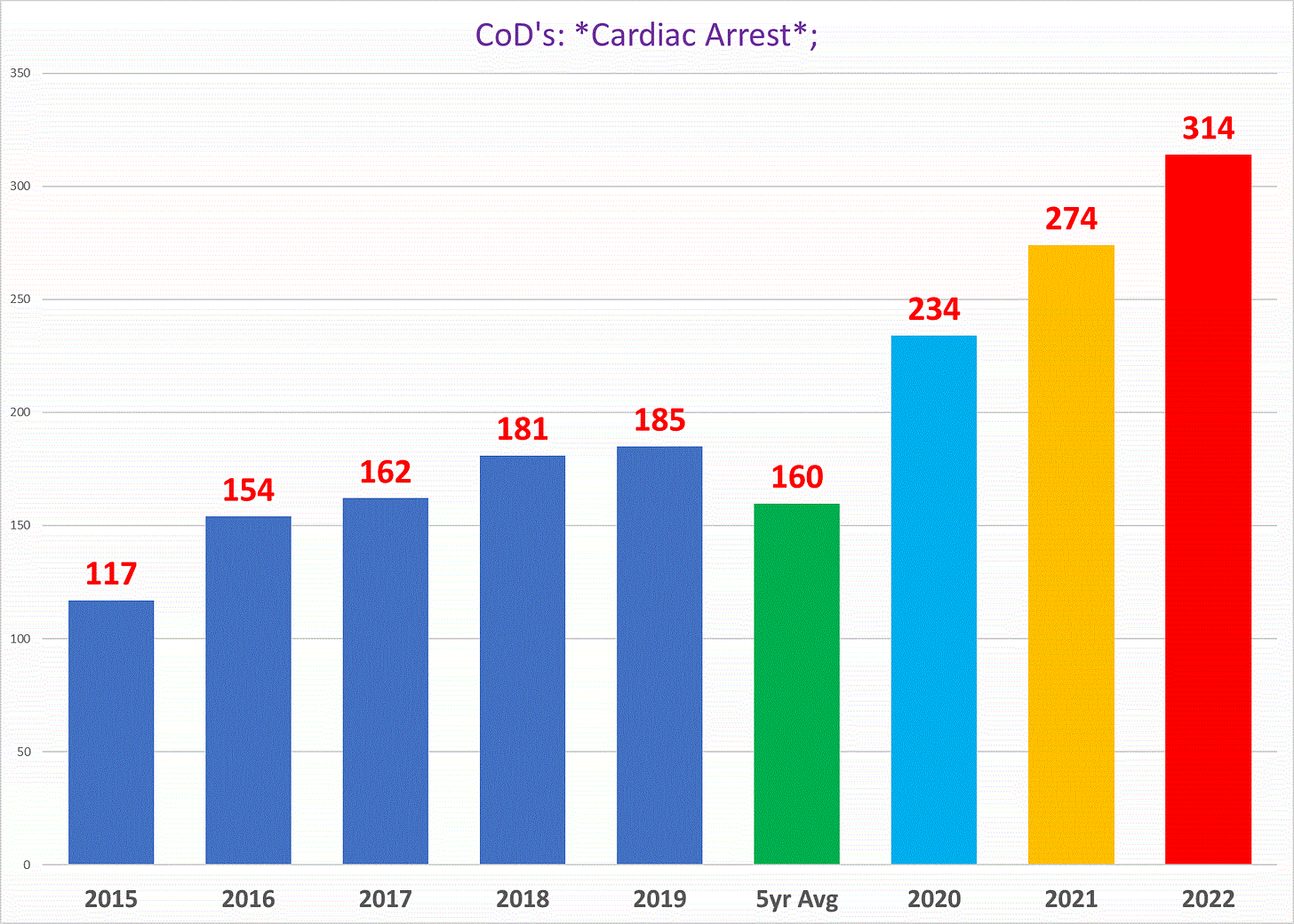
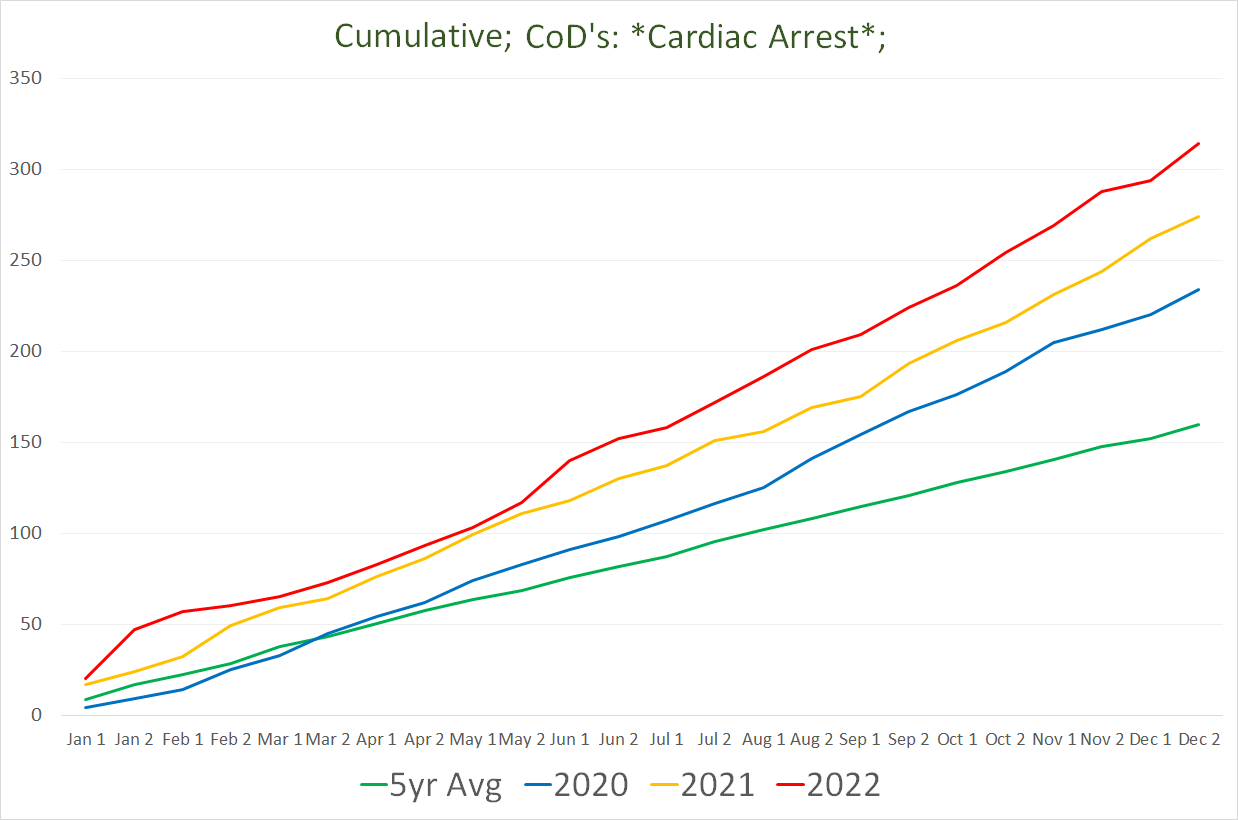
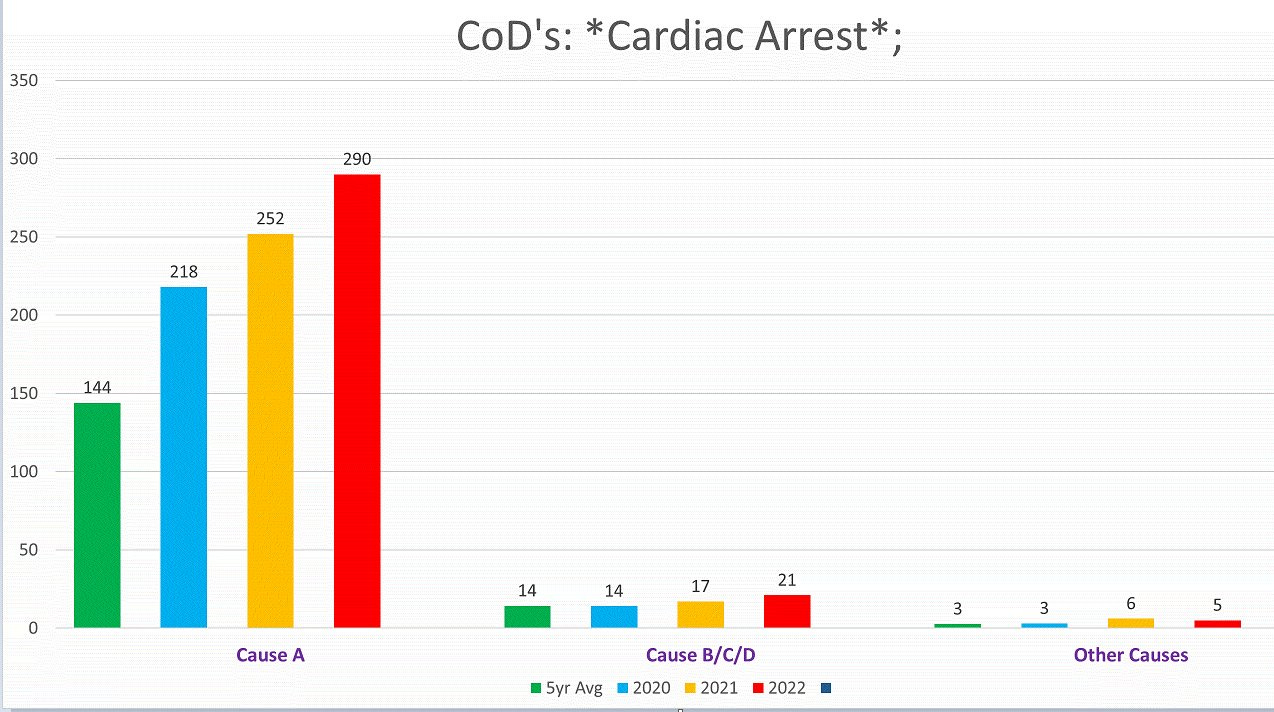





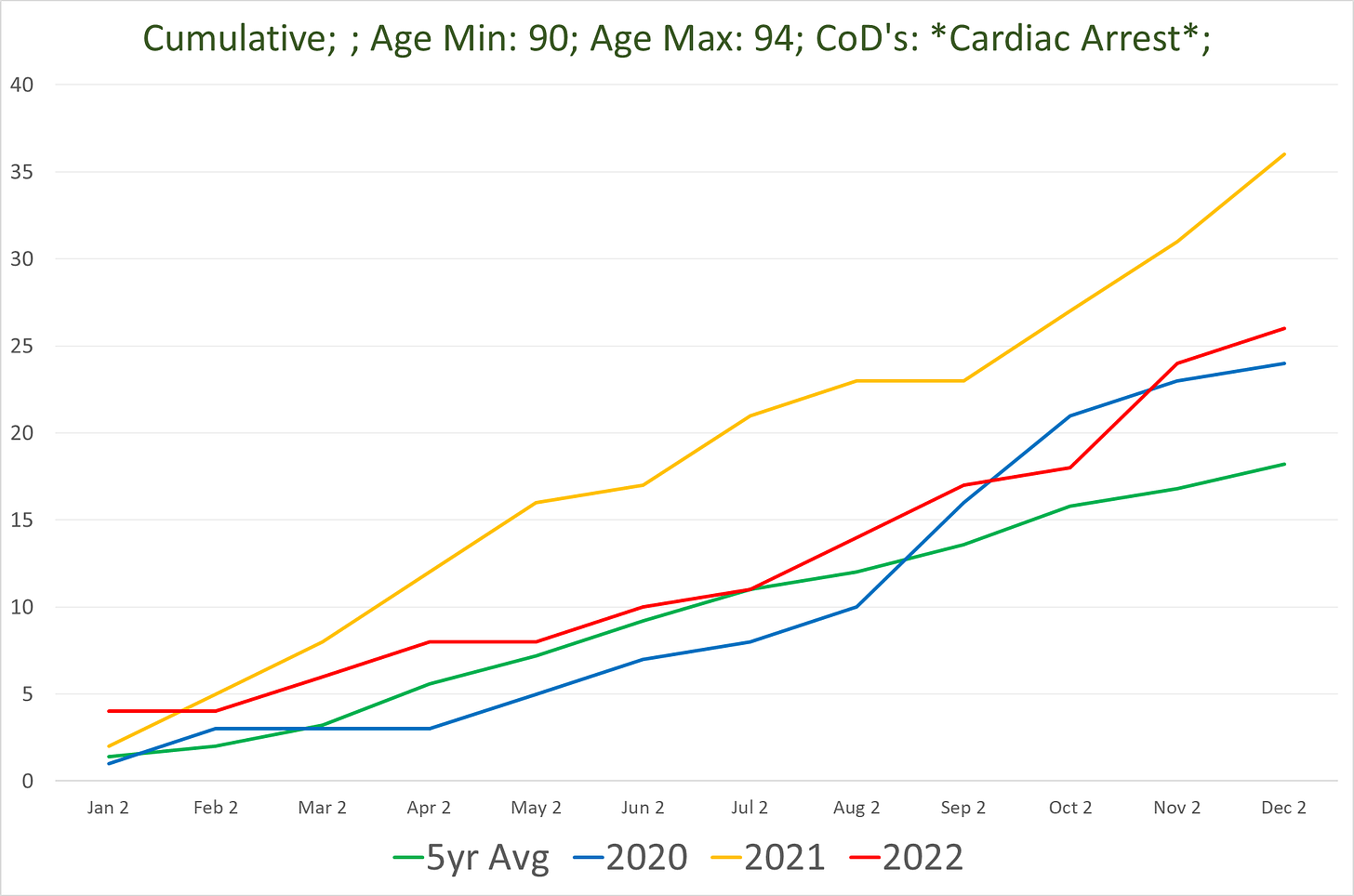
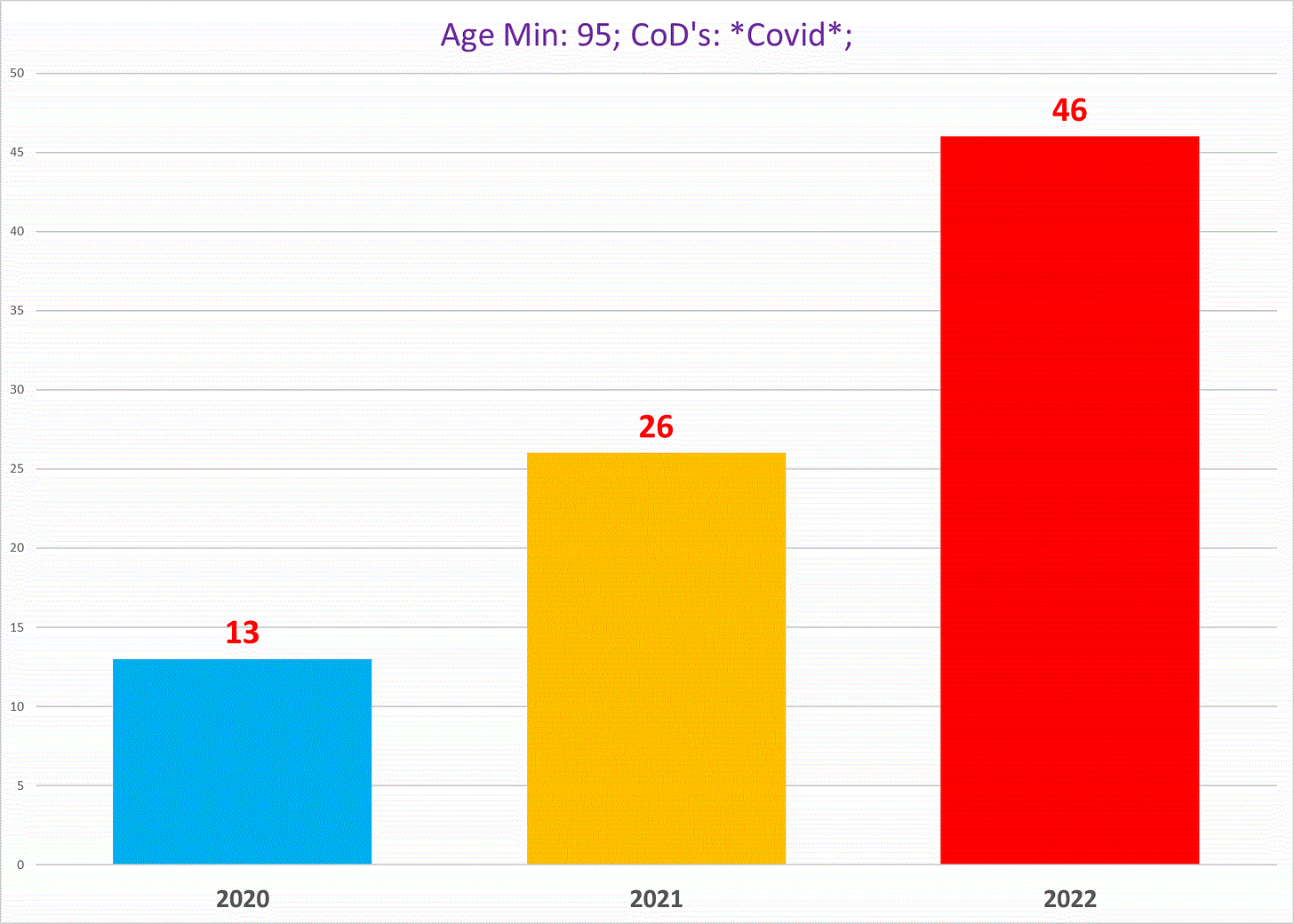

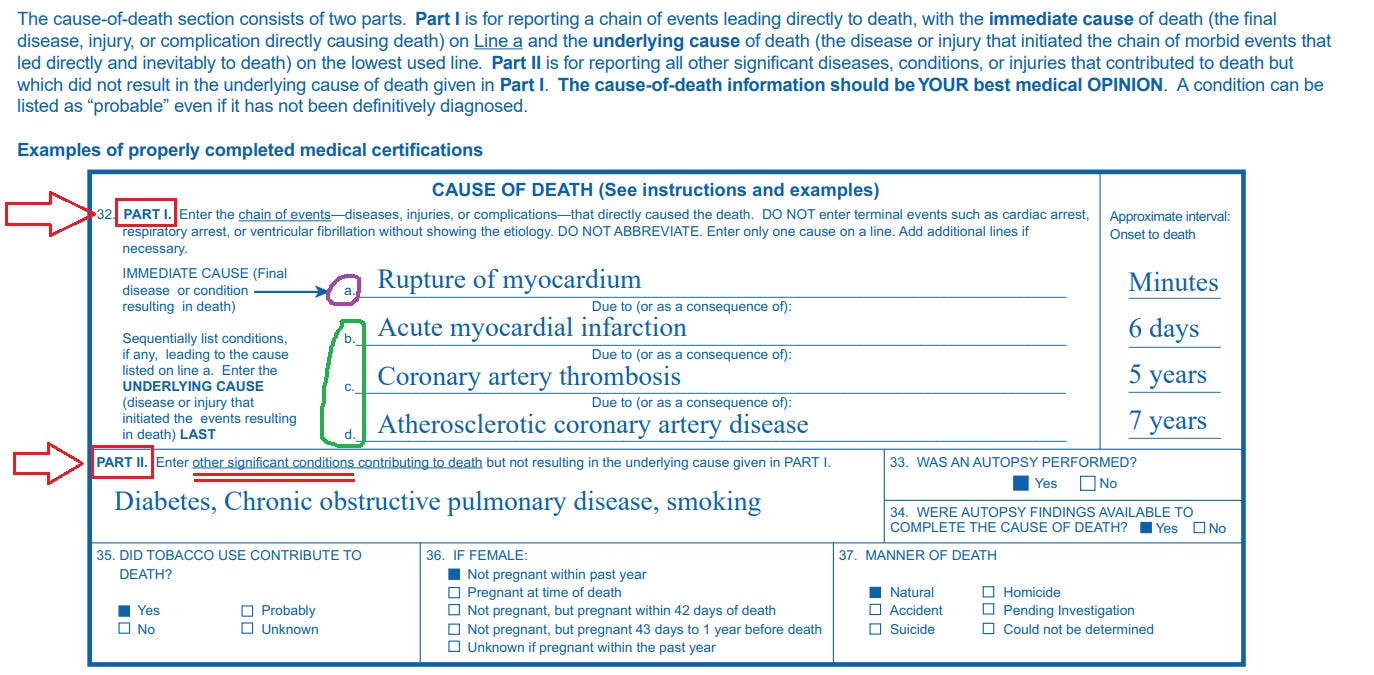

Probably just long COVID. Many such cases.
https://cjwhitmore.surge.sh
Can you look up the incidences of Interstitial Lung Disease? My father-in-law, here in Vermont, was just diagnosed with Pulmonary Hypertension with Scarring. He has had numerous shots - doesn't smoke.